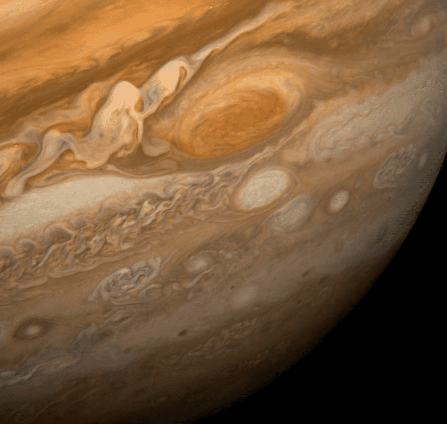
|
Explanation: What makes the colors in Jupiter's clouds? With a mean temperature of 120 degrees Kelvin (-153 degrees Celsius) and a composition dominated by Hydrogen (about 90%), and Helium (about 10%) with a smattering of hydrogen compounds like methane and ammonia, astronomers have been hard pressed to explain the blue, orange and brown cloud bands and the salmon colored "red" spot. Trouble is -- at the cool cloud temperatures Jupiter's atmospheric constituents should be colorless! Some suggest that more colorful hydrogen compounds well up from warmer regions in the atmosphere, tinting the cloud tops. Alternatively, compounds of trace elements like sulfur may color the clouds. The colors do indicate the clouds' altitudes, blue is lowest through red as highest. The dark colored bands are called belts and the light colored ones zones. In addition to the belts and zones, the Voyager missions revealed the presence of intricate vortices visible, for example, in this 1979 image from the Voyager I flyby. Centuries of visual observations of Jupiter have revealed that the colors of its clouds are ever changing.
|
January February March April May June July August September October November December |
| ||||||||||||||||||||||||||||||||||||||||||||||||
NASA Web Site Statements, Warnings, and Disclaimers
NASA Official: Jay Norris. Specific rights apply.
A service of: LHEA at NASA / GSFC
& Michigan Tech. U.
Based on Astronomy Picture
Of the Day
